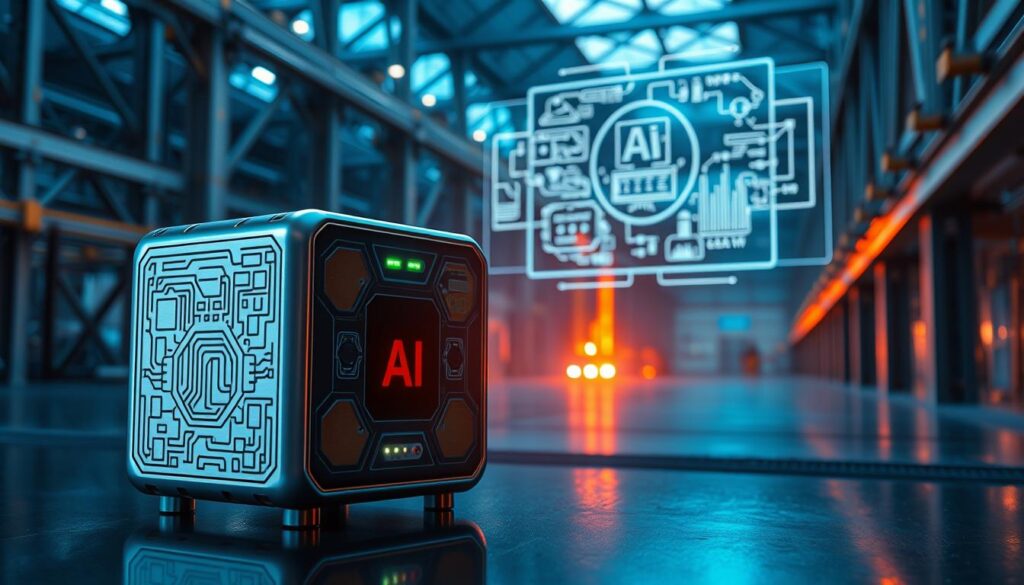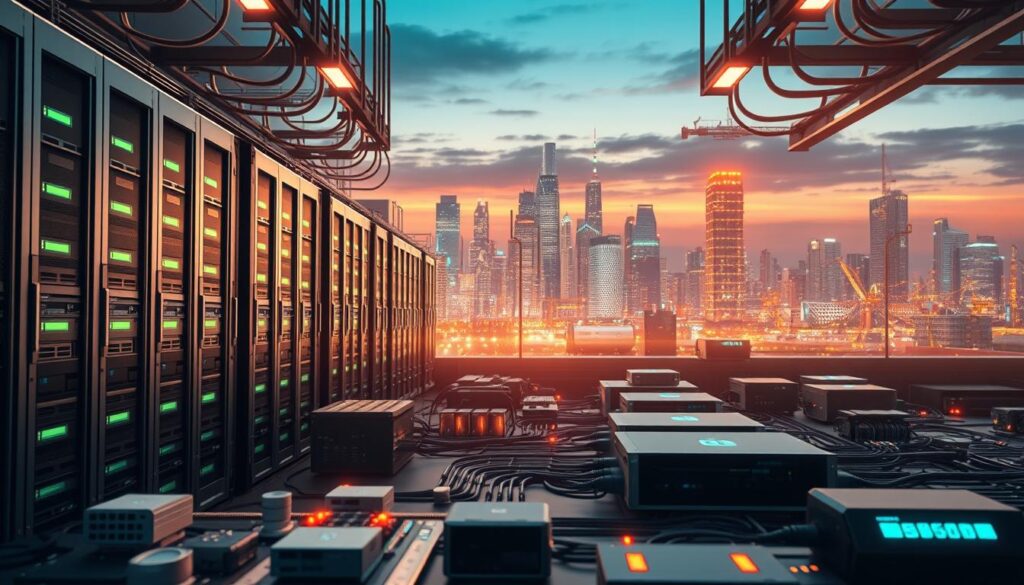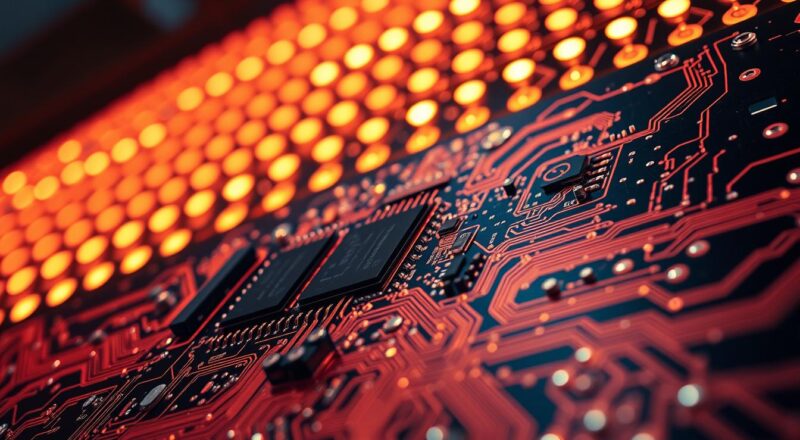Edge AI marks a new era of connectivity. It combines artificial intelligence with edge computing. This blend is shaping a future where learning at the edge is regular. Thanks to Edge AI, smart devices can now analyze data in real-time. This expands what IoT devices can achieve, bringing them closer to the data source.
Edge AI shows off human creativity. It is vital for fields like self-driving cars and smart healthcare. By making decisions locally, Edge Artificial intelligence speeds up crucial tasks. In our fast-paced world, merging AI with edge computing evolves the IoT world, full of new chances.
Your wearable might soon warn you of health issues before they worsen. Or, a factory could predict when machines need fixing. This exciting change is thanks to Edge Artificial intelligence. It not only keeps data secure but also boosts operational efficiency. This emerging AI and edge computing connection opens doors to a smarter world
What Is Edge AI?
- Key Takeaways
- The Evolution of Edge AI
- Understanding the Mechanics of Edge Artificial intelligence
- Real-World Applications of Edge Artificial intelligence
- Edge Artificial intelligence: A Catalyst for IoT Growth
- Benefits of Edge Artificial intelligence
- Edge AI Challenges and Solutions
- Future Trends in Edge Artificial intelligence Technology
- Edge AI Technology: Deep Dive into Artificial intelligence Algorithms and Neural Networks
- Conclusion
Key Takeaways
- Edge Artificial intelligence significantly reduces latency, enhancing real-time decision-making across various sectors.
- By processing data locally, Edge AI bolsters privacy and data security.
- Scalability and interoperability with 5G networks are made possible through Multi-Access Edge Computing (MEC) advancements, propelling AI to new heights.
- Real-world applications of Edge AI demonstrate its transformative impact in industries such as automotive, healthcare, smart cities, retail, and industrial IoT.
- The shift from cloud computing to Edge AI exemplifies the drive for immediate data processing and analytics at the source.
- Across industries, Edge AI is synonymous with enhanced operational efficiency, reliability, and lower costs.
The Evolution of Edge AI
The landscape of Edge AI technology has changed a lot, moving from cloud computing to real-time data processing on the spot. This move has been huge, going from big data centers to edge devices. It has made things better in many areas.
At first, Edge AI aimed to fix slow response times by moving data handling from the cloud to edge devices. This was key for things like self-driving cars and smart medical devices that need quick data handling. By using edge computing, systems now solve complex tasks right where they are. This cuts down on waiting times and makes things more efficient.
Machine learning being added straight into edge devices has been a game-changer. It lets devices improve by themselves without constant updates from afar. This change leads to autonomous edge devices that can process data by themselves. This change is very important in healthcare, where making fast decisions can save lives.

Edge servers are being used more than ever. They started with delivering web content faster in the 1990s. Now, they’re used in smart devices and factories. This move has led to a big increase in servers at the edge. It’s expected to keep growing and play a big role by 2024.
The use of Edge AI applications is on the rise with 5G and mixing cloud setups. This makes edge solutions better and easy to grow. This ongoing improvement is setting edge computing up for a big role in the future of tech.
In summary, moving from old-school cloud setups to edge processing has changed how we handle data. Edge Artificial intelligence technology has become a key part of modern tech. This change is driven by the need for quick, on-site data handling and self-running operations. It lets various fields use AI more effectively.
Understanding the Mechanics of Edge Artificial intelligence
In our journey, we see how edge computing is key. It brings computation and data storage right to where we need it. By doing this on local devices, like smartphones, it cuts down on delays. It also saves bandwidth. This sets up a strong base for AI algorithms to work better.
What is Edge Computing?
Edge computing means data is processed close to where it’s made, not in distant data centers. This makes things faster and keeps data more private. With more IoT devices, edge computing is crucial for handling their data.

How AI Enhances Edge Computing
Combining Artificial intelligence with edge computing changes how machines learn. They use deep learning to do tasks like recognizing images right on local devices. This means faster responses without needing distant servers. It makes decisions quick right where they’re needed.
Edge AI makes reactions faster and more personal. It also makes data safer. By keeping data local, we lower the risk of leaks. Edge AI can work within device limits, helping in many fields. It values speed, efficiency, and privacy.
Edge AI is growing by adding specialized hardware to devices. This helps with energy use and limits of computing power. As we create new things, this blend of edge computing and AI changes many industries. It proves edge intelligence is a key part of today’s tech.
Real-World Applications of Edge Artificial intelligence
Edge AI technology is changing many sectors. It brings computing power right to the data sources. This makes things faster and smarter. In areas like cars, making things, and health, edge Artificial intelligence and IoT sensors are making big changes. We’ll look at how edge Artificial intelligence is changing the world and why it’s so important.
Autonomous Vehicles and Safety
Edge AI is crucial for self-driving cars because it processes data right away. This helps the car make quick decisions. It makes the roads safer and self-driving cars work better. With edge AI, cars understand and react to road changes fast. This makes driving them safer and more reliable.
Manufacturing Efficiency
In making things, edge AI helps predict problems and act fast. IoT sensors with edge AI notice machine issues early. This stops big problems and keeps things running smoothly. Smart sensors handle data right where they are. They help keep making things without stopping. So, operations run better and more efficiently.
Smart Healthcare Devices
Edge Artificial intelligence is key in smart health by making devices that check and analyze in real-time. These devices process health info quickly. This is great for urgent health situations. Fast data means quick and right diagnoses. Edge Artificial intelligence in wearables and diagnostic tools helps care for patients better and faster.

These examples show edge Artificial intelligence‘s role in new ideas, better work, and safety in different fields. As edge AI grows, more devices and systems will use it. This means smarter and better solutions for everyday life.
Edge Artificial intelligence: A Catalyst for IoT Growth
Edge AI and IoT together are changing how we use devices. A IoT combines IoT devices with advanced AI. It’s reshaping many areas, like safety in cities and how shops work, by making environments smarter.
These edge AI solutions make IoT devices much better. They process data fast right where it’s collected. This cuts down on waiting times linked to the cloud. It makes smart devices quicker and smarter in making decisions.
Because of edge AI, devices can work on their own with little help from us. As edge AI gets better, it’s easier to put AI into devices. This makes IoT systems much smarter and quicker to respond.

Edge Artificial intelligence and IoT together are a big step forward. They improve how things work and create intelligent spaces. A IoT is changing different fields, showing that this mix of technology is key for future smart devices.
Benefits of Edge Artificial intelligence
Edge AI technology is transforming industries and enhancing user experiences. It improves real-time analytics and ensures data privacy. This technology is changing how we process and use data at the network’s edge.

Read more: Low-Tech Ways to Go Green at Home: Simple Habits for Sustainable Living
Read more: Sustainable Living Without Expensive Gadgets
Read more: Extended Reality Master Guide 2024
Edge Artificial intelligence reduces latency, which is vital for real-time processing like in autonomous vehicles. It processes data locally, cutting down the time for information to travel. This enables quick actions, important in health care and public safety.
Data privacy and security get a big boost from Edge Artificial intelligence. It processes sensitive information on local devices, reducing data breach risks. This keeps personal data much safer, meeting strict privacy laws easily.
Edge AI also makes better use of bandwidth. By processing data on local devices, it cuts down on the need for constant cloud use. This helps in places with poor connectivity or where saving bandwidth matters.
Plus, Edge Artificial intelligence is cost-effective. It lowers the need for costly cloud resources, ideal for real-time applications. Using edge computing on local devices saves money and improves reliability without spending more on cloud services.
Edge AI doesn’t just improve technology; it gives a strategic edge by making solutions scalable and secure. These benefits lead to better performance in many fields. Edge Artificial intelligence is key in advancing technology.
Edge AI is paving the way for a smarter, more connected, and technologically empowered future, making it a cornerstone of modern digital transformation strategies.
Edge AI Challenges and Solutions
This “Edge Artificial intelligence technology” is amazing but comes with challenges. We must find solutions that fit the unique needs of edge computing. This includes tackling hardware limits, improving scalability, and making speedy decisions. We are determined to make edge AI work well in many real-world situations.
Edge devices often don’t have much computing power. This means we need smart algorithms and models made just for edge use. Companies like NVIDIA and Intel lead the way. They make strong systems that can tweak models to fit on smaller devices. This is done using methods like quantization and pruning.
Keeping data safe on edge devices is a big worry. We have to use strong security steps to protect information. Advanced encryption and safe data channels help keep privacy strong. We also make sure our models can handle changing environments without failing.
We need edge devices to work well with the cloud. So, we use good APIs and designs that can change as needed. This lets edge and cloud systems work together smoothly. It ensures we can grow without dropping performance.
Making sure everything works together smoothly is key. We use models and frameworks that fit many types of hardware and software. Choosing designs that work with any hardware and managing resources wisely are important.
To make edge AI better, we must face and beat these challenges. This includes making data more secure, quick decision-making, and allowing growth. With each step, we make stronger edge computing solutions. As we keep improving, edge AI’s potential gets bigger, changing many industries.
Future Trends in Edge Artificial intelligence Technology
The world of tech is changing fast with edge Artificial intelligence leading the way. Thanks to advanced AI algorithms and 5G’s growth, we’re entering a new age of innovation. Neural networks and machine learning are changing how devices process data on-site. This means smarter, faster solutions right where we need them.
Advancements in Neural Networks and Machine Learning
Neural networks and machine learning are really pushing edge Artificial intelligence forward. By using NVIDIA’s Jetson series and ARM’s brain-like processors, devices get smarter. They can learn from data right away without needing the cloud’s help.
Edge Artificial intelligence in the Era of 5G
5G technology is making a big difference for edge AI. With less delay and more data capacity, 5G lets us do complex Artificial intelligence tasks instantly. By 2026, with 8 billion 5G connections, edge AI will grow, especially in quick-data areas like self-driving cars and smart cities.
Interoperability Between Edge and Cloud Computing
Getting edge and cloud computing to work together is key for growing artificial intelligence. Edge AI and cloud AI working together make things work better and use less energy. For instance, Edge AI SDK from Advantech helps deploy AI models on different chips like Intel and Qualcomm, making Artificial intelligence more flexible.
Edge AI is changing many fields, from farming to space exploration. It makes data processing and decision-making fast and safe. With edge Artificial intelligence, we’re moving toward a future where smart solutions blend into our everyday lives beautifully.
| Technology | Impact on Edge Artificial intelligence | Example |
|---|---|---|
| 5G Networks | Ultra-low latency supporting real-time AI | Autonomous vehicles, Smart cities |
| Neural Networks | Improved machine learning processes at the edge | NVIDIA Jetson Series, ARM chipsets |
| Interoperability | Enhanced cloud-edge integration | Advantech’s Edge AI SDK, Cloud AI synergy |
Looking ahead, integrating things like tiny ML models in IoT devices will change Edge AI. Neural processing units in PCs will also boost Edge AI. It’s becoming a key part of our digital future.
Edge AI Technology: Deep Dive into Artificial intelligence Algorithms and Neural Networks
Edge AI technology mixes Artificial intelligence algorithms and neural networks for on-device thinking and learning. These networks copy how humans process text, speech, and visual info. They make Edge Artificial intelligence crucial in today’s tech. They boost intelligence on devices and allow for smart, local model operation and growth.
Deep learning uses neural networks with layers including input, hidden, and output layers. These layers talk to each other. During training, they adjust to get smarter. This process improves how artificial intelligence at the edge understands complex information.
Edge AI applications are shifting the AI paradigm, moving the hefty computations from cloud to localized environments. This not only slashes latency periods but significantly reduces the reliance on bandwidth-hungry cloud servers.
Edge AI combines on-device learning and cloud power. The cloud helps train artificial intelligence models at first. Then, these models work at the edge. They process data and make quick decisions. This is key in fields like factory maintenance and healthcare.
Technological growth like neural networks gets a boost from more IoT devices and 5G. Edge intelligence grows, letting machines do complex local tasks. Edge computing and Artificial intelligence create a smarter, quicker system. It can change many areas from manufacturing to smart cities.
The future of Edge Artificial intelligence leans on better neural networks and learning tech. As these improve, they will change many sectors. They offer new ways to work and open up new business chances.
In summary, neural networks and artificial intelligence algorithms make machine learning at the edge strong. This spreads Artificial intelligence abilities and meets privacy needs by keeping data local. This marks a big step in tech use and growth at the edge.
Conclusion
Edge AI is changing how we handle data at the networks’ edge. It makes data analysis fast and local. This technology combines edge computing’s best with instant analysis. This gives us quick answers, better privacy, and more efficiency.
Healthcare and cars are using Edge AI for better systems. The Edge AI market is now huge, showing how much people want this smart tech. We already use it for things like fixing machines before they break. This shows Edge AI will be big in our future tech world.
Yet, making Edge AI work everywhere won’t be easy. We need to solve problems with hardware and making models better. But, with faster networks and new AI chips coming, there’s hope. Edge AI’s growth tells us we’re near a big change. It’s a thrilling time as Edge AI makes our world smarter and more connected.
Get in Touch with SJ Articles
Read more: Neuromorphic Computing: The Future of AI-Powered Processors
Read more: Semiconductor Technology | What Exactly is an semiconductor?
Read more: AI-Powered Budgeting Tools You Can Use Today


